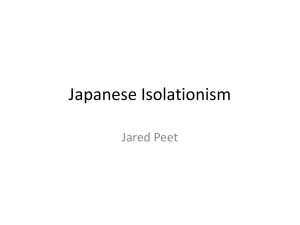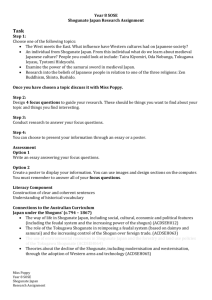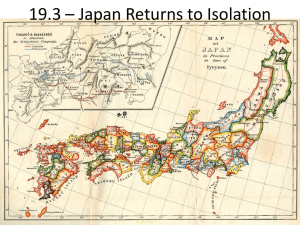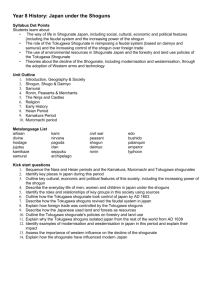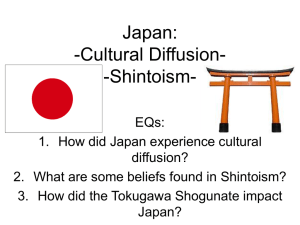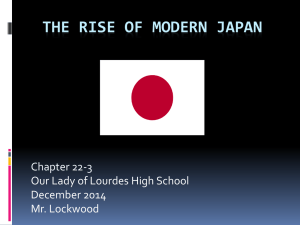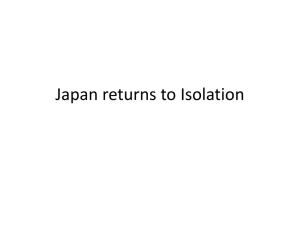Japan under the Shoguns Year 8 Program
advertisement
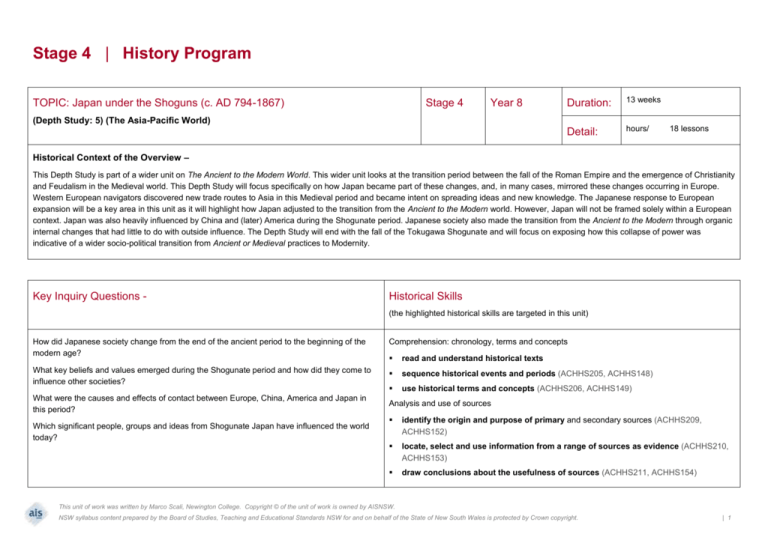
Stage 4 | History Program TOPIC: Japan under the Shoguns (c. AD 794-1867) Stage 4 Year 8 Duration: 13 weeks Detail: hours/ (Depth Study: 5) (The Asia-Pacific World) 18 lessons Historical Context of the Overview – This Depth Study is part of a wider unit on The Ancient to the Modern World. This wider unit looks at the transition period between the fall of the Roman Empire and the emergence of Christianity and Feudalism in the Medieval world. This Depth Study will focus specifically on how Japan became part of these changes, and, in many cases, mirrored these changes occurring in Europe. Western European navigators discovered new trade routes to Asia in this Medieval period and became intent on spreading ideas and new knowledge. The Japanese response to European expansion will be a key area in this unit as it will highlight how Japan adjusted to the transition from the Ancient to the Modern world. However, Japan will not be framed solely within a European context. Japan was also heavily influenced by China and (later) America during the Shogunate period. Japanese society also made the transition from the Ancient to the Modern through organic internal changes that had little to do with outside influence. The Depth Study will end with the fall of the Tokugawa Shogunate and will focus on exposing how this collapse of power was indicative of a wider socio-political transition from Ancient or Medieval practices to Modernity. Key Inquiry Questions - Historical Skills (the highlighted historical skills are targeted in this unit) How did Japanese society change from the end of the ancient period to the beginning of the modern age? Comprehension: chronology, terms and concepts read and understand historical texts What key beliefs and values emerged during the Shogunate period and how did they come to influence other societies? sequence historical events and periods (ACHHS205, ACHHS148) use historical terms and concepts (ACHHS206, ACHHS149) What were the causes and effects of contact between Europe, China, America and Japan in this period? Analysis and use of sources Which significant people, groups and ideas from Shogunate Japan have influenced the world today? identify the origin and purpose of primary and secondary sources (ACHHS209, ACHHS152) locate, select and use information from a range of sources as evidence (ACHHS210, ACHHS153) draw conclusions about the usefulness of sources (ACHHS211, ACHHS154) This unit of work was written by Marco Scali, Newington College. Copyright © of the unit of work is owned by AISNSW. NSW syllabus content prepared by the Board of Studies, Teaching and Educational Standards NSW for and on behalf of the State of New South Wales is protected by Crown copyright. | 1 Framing Questions Content Question: What is a Shogun? What was life like in Shogunate Japan? Conceptual Question: How did the Shogunate period change Japanese society? To what extent was European influence responsible for the decline of the Shogunate period? Perspectives and interpretations identify and describe different perspectives of participants in a particular historical context (ACHHS212, ACHHS155) Empathetic understanding Contestable Question: Was the Shogunate period a period of success in Japan? interpret history within the context of the actions, attitudes and motives of people in the context of the past (ACHHS212, ACHHS155) Research ask a range of questions about the past to inform an historical inquiry (ACHHS207, ACHHS150) identify and locate a range of relevant sources, using ICT and other methods (ACHHS208, ACHHS151) use a range of communication forms and technologies Explanation and communication Outcomes develop historical texts, particularly explanations and historical arguments that use evidence from a range of sources (ACHHS213, ACHHS156) select and use a range of communication forms (oral, graphic, written and digital) to communicate effectively about the past (ACHHS214, ACHHS157) Historical Concepts (the highlighted historical concepts will be targeted in this unit) HT4-2: describes major periods of historical time and sequences events, people and societies from the past. Continuity and change: what aspects of Japanese society changed, and what aspects stayed the same, during the Shogunate period? HT 4-4: describes and explains the causes and effects of events and developments of past societies over time. HT 4-6: uses evidence from sources to support historical narratives and explanations. Cause and effect: what were the reasons for the rise of the Shogunate period? How did political power change under the Shogun? What caused the decline of the Shogunate? How did this decline come to affect Japan? HT 4-7: identifies and describes different contexts, perspectives and interpretations of the past. HT 4-9: uses a range of historical terms and concepts when communicating an understanding of the past. Perspectives: how did Westerners view Japan? How did the Japanese view westerners during the Shogunate period? How do we assess the Shogunate period from a modern Western, liberal perspective? HT 4-10: selects and uses appropriate oral, written, visual and digital forms to Empathetic understanding: what was it like to live in Shogunate Japan? How was everyday life different to that of the Shoguns? How was life in Shogunate Japan different to This unit of work was written by Marco Scali, Newington College. Copyright © of the unit of work is owned by AISNSW. NSW syllabus content prepared by the Board of Studies, Teaching and Educational Standards NSW for and on behalf of the State of New South Wales is protected by Crown copyright. | 2 Outcomes Historical Concepts (the highlighted historical concepts will be targeted in this unit) communicate about the past. life in Australia today? Is life in Shogunate Japan the same as life in any other modern day society? Significance: the importance of the Shogun and the Daimyo and its impact on Japanese society and politics. The importance of European influence and its impact on the decline of the Shogunate period. Contestability: Did the Tokugawa Shogunate collapse because of external influence, internal factors, or both? Was the Shogunate period a time of “success” in Japan’s history? Key Historical Terms & Concepts Site Study Samurai, Daimyo, Emperor, Shogun (seii taishogun), Shogunate, Modernisation, Westernisation, Feudalism (Shi-No-Ko-Sho), Clans, Vassals, Provinces (domains), Palanquins, Seppuku, Bushido, Ronin, Shintoism, Buddhism, Christianity, Confucianism, Isolationism, Restoration, Treaty. British museum http://www.britishmuseum.org/explore/highlights/articles/j/japanese_samurai_and_shoguns.aspx https://www.britishmuseum.org/explore/highlights/articles/j/japan_edo_period.aspx Metropolitan Museum of Art http://www.metmuseum.org/toah/hd/shga/hd_shga.htm http://www.metmuseum.org/toah/ht/?period=08&region=eaj Resources Resources Books You Tube Clips, Documentaries, DVDS – Robert Darlington (et al), History Alive: For the Australian Curriculum. Jacaranda (2012) Chapter 8. http://documentarystorm.com/kublai-khans-lost-fleet/ (good on the invasion of the Mongols) Ken Webb (ed.), History 9 (Stage 5): NSW Syllabus for the Australian Curriculum. Cambridge (2013) Chapter 6. http://topdocumentaryfilms.com/japan-memoirs-secret-empire/ (the fantastic PBS series on Shogunate Japan) This unit of work was written by Marco Scali, Newington College. Copyright © of the unit of work is owned by AISNSW. NSW syllabus content prepared by the Board of Studies, Teaching and Educational Standards NSW for and on behalf of the State of New South Wales is protected by Crown copyright. | 3 Resources Resources Bruce Dennett and Stephen Dixon, Insight History: Australian Curriculum for NSW- Stage 4- 8. Oxford (2013) Chapter 12. http://www.youtube.com/watch?v=EmTZnnbqfsc (comprehensive) Richard Storry, A History of Modern Japan. Penguin (1960) Vic Guest (et al), Tradition and Change. Jacaranda (1984) Unit 2 (C). Stuart Fewster and Tony Gorton, Japan: From Shogun to Superstate. Paul Norbery Publications (1988) Websites http://www.britishmuseum.org/explore/highlights/articles/j/japanese_samurai_and_shoguns.as px http://www.metmuseum.org/toah/ht/?period=08&region=eaj http://teacherlibrarianhelp.com/research-guides/61-2/ http://www.samurai-archives.com/historyindex.html http://www.britannica.com/EBchecked/topic/541431/shogunate http://www.pbs.org/empires/japan/resources_3.html (connected with the PBS documentary series) http://japan.mrdonn.org/index.html (free extra lesson plans on this topic) http://www.socialstudies.com/c/worldlinks.html?s@_cfLZwdregPSQ#5 (great overview of whole topic) http://www.ubcpress.ca/books/pdf/chapters/forestry_japan/chap1.pdf (about forestry in Shogunate Japan) http://afe.easia.columbia.edu/tps/1450_jp.htm (great info on all Japanese history) http://topdocumentaryfilms.com/the-samurai/ (documentary on the Samurai) http://www.youtube.com/watch?v=6mN-AKhzNH0 (short clip that shows how Katana swords are made) http://www.youtube.com/watch?v=Y9NBZRl9aD4 (Shogun: The Supreme Samurai- Doco) http://www.youtube.com/watch?v=pqX0_QPNVmE (Lost Treasures of the Ancient World- Doco) http://www.youtube.com/watch?v=uqVYa6dp_94 (a run through of how Age of Empires 3 works) http://www.youtube.com/watch?v=LIW6a1BsUcU (gameplay trailer for Shogun 2:Total War) Akira Kurosawa, Seven Samurai (1954) Akira Kurosawa, Throne of Blood (1957) Edward Zwick, The Last Samurai (2003) (looks more at the period of Meiji, but good for showing connections between Japan and outside cultures (American) http://akirakurosawa.info/akira-kurosawa-movies-on-dvd/ (has excellent information on where to purchase all Kurosawa films on DVD) Computer Games Age of Empires 3 – The Asian Dynasties (Japan Campaign Mode) (simulation game that involves the building up of the Tokugawa Shogunate)- (available on PC) and Shogun: Total War (or Shogun 2: Total War) updated 2011 version. http://en.wikipedia.org/wiki/Akira_Kurosawa (info on Kurosawa) http://en.wikipedia.org/wiki/Seven_Samurai (Seven Samurai) http://en.wikipedia.org/wiki/Throne_of_Blood (Throne of Blood) http://en.wikipedia.org/wiki/Shogun:_Total_War (explanation of “Shogun: Total War”) http://en.wikipedia.org/wiki/Age_of_Empires_3:_The_Asian_Dynasties This unit of work was written by Marco Scali, Newington College. Copyright © of the unit of work is owned by AISNSW. NSW syllabus content prepared by the Board of Studies, Teaching and Educational Standards NSW for and on behalf of the State of New South Wales is protected by Crown copyright. | 4 Assessment overview Depth Study 5 Semester 1/2 Stage 4- Year 8 Japan under the Shoguns (A.D. 794-1867) Terms 2 and 3 , Weeks 2-8 (T2), Weeks 1-6 (T3) Assessment for learning Assessment as learning Assessment of learning The following are a list of opportunities throughout the unit of work to check on student learning and understanding: The following are a list of opportunities throughout the unit of work that will allow a student to monitor their own learning and assess their progress: Weighting: 50% Group presentations (oral) in front of class. Individual written reports based on timelines and questions. Table showing the roles of different groups in Japanese social system. Group research findings on google doc – written report. Powerpoints/Prezi on Japanese castles. Travel brochure on timber structures in Japan. Primary and secondary source work- extracting quotes, analysis of origins, nature, content, context and perspective of sources. Class debate on Japanese modernisation. Group presentations. Poster work on legacy of Shogun period in modern Japan. Peer-marking/review of Japanese castles Powerpoint/Prezi task. Peer review can also take place on written reports and travel brochure exercise. Student written reflection before and at end of class debate on whether Japan needed to modernise or not. Students develop marking criteria for poster exercise at the end of topic (Content Area 4, Lesson 6). At the completion of the task, student groups mark the posters of other groups based on an agreed criteria (whole-class developed criteria). Groups come to a consensus on a mark and then write a comment for the poster work. Discussion and reflection of marking process at end of topic. Reflection survey at end of assessment task Student/teacher plenary session to conclude unit of work and findings of survey. Student outlines what they have learnt in the unit (content and skills) and strengths and weaknesses in their knowledge and skills. Description of Task: Students conduct a critical analysis into a computer game or film that relates to the Shogunate Japan topic. Students will present a research paper that looks at three distinct questions that relate to their computer game or film text. They will firstly explore the historical context which their media text is situated in. Then they will critically assess the historical accuracy of their text. Lastly, they will draw wider conclusions on the values and limitations (usefulness) of media texts to historians and historical understanding. Outcomes: HT4-2, HT4-6, HT4-7, HT4-9, HT4-10 This unit of work was written by Marco Scali, Newington College. Copyright © of the unit of work is owned by AISNSW. NSW syllabus content prepared by the Board of Studies, Teaching and Educational Standards NSW for and on behalf of the State of New South Wales is protected by Crown copyright. | 5 Content Teaching and learning strategies Resources including opportunities for extension activities & adjustments Stage 4 - Depth Study 5: AsiaPacific World Content Area 1: The way of life in Shogunate Japan, including social, cultural, economic and political features (including the feudal system and the increasing power of the shogun) (ACDSEH012) Students: sequence the Nara and Heian periods and the Kamakura, Muromachi and (5 lessons) Darlington (et. al) Chapter 8 p.231-243. Lesson 1: Geography of Japan. Use google earth to locate key cities and islands of Japan. Students should copy map into their books with key cities of Nara, Kyoto, Edo (Tokyo), Kamakura, Osaka, Nagasaki indicated. Also, students should label islands of Kyushu, Shikoko, Honshu and Hokkaido. In groups, students should be allocated a key city to research. Students conduct a web-based inquiry looking specifically at two areas: Google Earth i) the historical importance of your city http://www.worldatlas.com/webimage/countrys/asia/j apan/jptimeln.htm (for time line of Japanese History) http://www.timemaps.com/history/japan-1648ad (more help with timelines) ii) the importance of your city in modern-day Japan. Vic Guest, Tradition and Change pp92-99. Findings of research are presented to class through group presentation. Kurosawa’s Seven Samurai Lesson 2: Chronology of Japanese history. Students develop timeline of key periods of Japanese rule from 794-1867. Key periods are Nara, Heian, Kamakura, Ashikaga, Warring States and Edo (Tokugawa). Darlington (p231) has a good table on this. Students also outline how and why power transitioned between Shogunates through a written report. http://documentarystorm.com/kublai-khans-lost-fleet/ (if time, can watch doco on Mongol invasions as an addition to lesson 2) Tokugawa Shogunates. identify key places in Japan during this period. outline key cultural, economic and political features of this society, including the increasing power of the shogun. describe the everyday life of men, women and children in Japan under Lesson 3: Feudal structure of Japan. Students look at the social structure of Shogunate Japan and develop a diagram of the social classes (social pyramid). Look specifically at the increasing role of the Shogun and why this role became so important in Japanese culture. Look at role of Daimyo and potential tension between Daimyo and Shogun. Who would become Shogun? What role did the Emperor have? Students create table with two columns. On the left hand side they list Emperor, Shogun and Daimyo. On right hand side they explain the importance and role of each. To develop IT skills, table can be constructed using Microsoft Word or Pages. the shoguns. identify the roles and relationships of key groups in this society using sources. Lesson 4: Everyday life. (Teacher-directed discussion using sources as stimulus- use paintings, diary entries, letters, secondary sources, clothing, weapons) What was life like for everyday people in Japan during the Shogunate period? How much was life dominated by war? Who could become Samurai? What role did religion play in Japanese life? Who made up the majority of the Japanese population (what social class)? What was This unit of work was written by Marco Scali, Newington College. Copyright © of the unit of work is owned by AISNSW. NSW syllabus content prepared by the Board of Studies, Teaching and Educational Standards NSW for and on behalf of the State of New South Wales is protected by Crown copyright. | 6 Content Teaching and learning strategies Resources including opportunities for extension activities & adjustments life like for women in Shogunate Japan? Students look at extracts from Sei Shonagon’s The Pillow Book and extract points/quotes that explain what life was like for women. Lesson 5: Case study- Who were the Samurai? Brainstorm asking students what they know about this term. Who were Ronin? Allow students to do a web search to find a definition of Ronin. Who were the 47 Ronin? Watch select scenes from Kurosawa’s Seven Samurai. As they watch the scenes, students note down points on what they learn about the Samurai from Kurosawa’s film. Class discussion at end of scenes to allow students to contribute their ideas. Content Teaching and learning strategies Resources including opportunities for extension activities & adjustments Content Area 2: (4 lessons) Darlington, pp230,231, 250, 251. The role of the Tokugawa Shogunate in re-imposing a feudal system (based on daimyo and samurai) and the increasing control of the shogun over foreign trade (ACDSEH063) Lesson 1: The rise of Tokugawa. The transition from Ashikaga Shogunate to Tokugawa. Study of key individuals. Students conduct research in groups on the following individuals, explaining their role in the transition from Ashikaga to Tokugawa power: Oda Nobunaga, Toyotomi Hideyoshi, Tokugawa Ieyasu. Students develop written report and oral presentation for class on their individual. https://www.britishmuseum.org/explore/highlights/articl es/j/japan_edo_period.aspx (this is one of several good links on the Edo period). Students: Lesson 2: Maintaining power in Tokugawa Japan. How did the Tokugawa Shoguns keep control of daimyo during the period of their rule? What were “palanquins”? Do you feel it was justified that the Tokugawa Shoguns kept such strict control? What problems may arise from such tactics? Can you think of alternative methods they could have used? Students research these questions in groups of five where each student is allocated a particular question. Collaborate and present final report on Google Doc. outline how the Tokugawa Shogunate took control of Japan by AD 1603. describe how the Tokugawa Shoguns http://www.us-japan.org/edomatsu/ (virtual tour of life in Edo during Tokugawa period) http://www.hokusaionline.co.uk/code/edo_period.html (breaks up social, economic and cultural change well from this period) http://www.japanese-castle-explorer.com/ (link with some extra information on Japanese castles). revived the feudal system. explain how foreign trade was Lesson 3: Case study- Japanese castles. Spend a period researching TWO Japanese This unit of work was written by Marco Scali, Newington College. Copyright © of the unit of work is owned by AISNSW. NSW syllabus content prepared by the Board of Studies, Teaching and Educational Standards NSW for and on behalf of the State of New South Wales is protected by Crown copyright. | 7 Content Teaching and learning strategies Resources including opportunities for extension activities & adjustments controlled by the Tokugawa Shoguns. castles that remain in modern-day Japan. Example could be Himeji Castle. Were castles owned by the Emperor, the Shogun or Daimyo? http://www.jcastle.info (will help students find information on castles). Students should create a Powerpoint or Prezi on their castle identifying its key features and providing a brief history of its historical importance. Lesson 4: Foreign trade. How was foreign trade controlled by Tokugawa Shoguns? Why did they wish to control foreign trade? Why would this be hard to do? Students conduct research into Nagasaki and Dejima Island. Was any contact allowed with foreign traders? What was “Rangaku”? Were traders ever allowed to visit the Shogun? Work is presented as written report. Content Teaching and learning strategies Resources including opportunities for extension activities & adjustments Content Area 3: (3 lessons) Google Earth The use of environmental resources in Shogunate Japan and the forestry and land use policies of the Tokugawa Shogunate (ACDSEH064) Lesson 1: Timber and forestry. Why was timber so important in Japan? Where was timber obtained? What problems occurred with timber usage in the Tokugawa period? How did Tokugawa Shoguns try to fix these problems? Students use Google Earth to locate areas in Japan that are heavily forested today and add these locations to the map they created in Content Area 1, Lesson 1. http://www.japan-guide.com/e/e4100.html (info on Todai-ji temple) Students: describe how the Japanese used land and forests as resources. outline the Tokugawa Shogunate's policies on forestry and land use. Lesson 2: Site study- timber structure in Japan. What is Todai-Ji? What is Kinkaku-ji? Have these timber structures been restored or re-built, or are they in original condition? Students develop a travel brochure for modern-day tourists travelling to these sites. http://en.wikipedia.org/wiki/Kinkaku-ji (info on Kinkaku-ji temple) http://www.youtube.com/watch?v=uqVYa6dp_94 (youtube clip introducing gameplay of Age of Empires III: Asian Dynasties). This unit of work was written by Marco Scali, Newington College. Copyright © of the unit of work is owned by AISNSW. NSW syllabus content prepared by the Board of Studies, Teaching and Educational Standards NSW for and on behalf of the State of New South Wales is protected by Crown copyright. | 8 Content Teaching and learning strategies Resources including opportunities for extension activities & adjustments Lesson 3: Simulation of Age of Empires III: Asian Dynasties (can be done on PC). What role does timber play in this simulation game? In what period of Japan’s history is this game set? What areas of Japan is the timber obtained from? What can be made with timber in this game? Is this an accurate reflection of how timber was used in the Shogunate period? Students answer these questions in their notebooks after experimenting with the game. Content Teaching and learning strategies Resources including opportunities for extension activities & adjustments Content Area 4: (6 lessons) Darlington (et al), pp238-241, 25-255, 234-235. Theories about the decline of the Shogunate, including modernisation and westernisation, through the adoption of Western arms and technology (ACDSEH065) Lesson 1: Western and Eastern religious influence in Japan during the Tokugawa period. Teacher exposition on the influence of Buddhism (including Zen), Christianity and Confucianism in Tokugawa Japan. Where did these religions originate from? Was there an indigenous Japanese religion (Shintoism)? Was the Emperor considered a descendant of Japanese gods/goddesses? Student research into religious buildings/shrines/statues in modern-day Japan. Present a written report on THREE different buildings/shrines/statues from Buddhism, Shintoism and Christianity (one from each). When were they built? How do these religious buildings reflect the diversity in Japanese religious history? What religion(s) do the people of Japan follow today? Students use gapminder.org to look for these statistics. Record findings in a table. Vic Guest, p. 95 and 116. Students: explain why the Tokugawa Shoguns isolated Japan from the rest of the world from AD 1639. identify examples of modernisation and westernisation in Japan in this period and explain their impact. assess the importance of Western influence on the decline of the Shogunate. explain how the Shogunate have Lesson 2: Coming of America. What role did America play in destroying Japan’s isolation? What happened in Edo in 1853? Who was Admiral Perry? Why was America looking to break Japanese isolation? What was happening in America at the same time as Perry’s excursion to Japan? Do you think this influenced America’s increased interest in Japan? What was the Treaty of Kanagawa? Primary source work. Students find FOUR primary sources (two American, two Japanese) related to the period of early American involvement in Japan. Students record quotes, labelling them with http://www.gapminder.org/ http://afe.easia.columbia.edu/special/japan_1750_perr y.htm (introduction to Admiral Perry and siege of Edo) https://history.state.gov/milestones/18301860/opening-to-japan (official State Department record of America’s role in Japan under Perry) http://afe.easia.columbia.edu/special/japan_1750_meiji .htm (information on the Meiji restoration) http://www.history.com/topics/meiji-restoration (will show the transition between Tokugawa period and Meiji) http://www.dailymail.co.uk/news/article-2310033/EndSamurai-Stunning-portraits-Japan-s-warrior-classcaptures-men-height-power-19th-century-demise.html (some great primary sources showing Samurai dress This unit of work was written by Marco Scali, Newington College. Copyright © of the unit of work is owned by AISNSW. NSW syllabus content prepared by the Board of Studies, Teaching and Educational Standards NSW for and on behalf of the State of New South Wales is protected by Crown copyright. | 9 Content Teaching and learning strategies Resources including opportunities for extension activities & adjustments influenced modern Japan author, date and source where they found it. Lesson 3: Civil war and the end of Tokugawa power. What happened in the ten years after the Treaty of Kanagawa? Why did fighting break out between the Japanese? What was the Nagasaki Naval Training Centre? Is this an example of Western influence helping Japan? Students conduct research into these areas and answer questions on a Google Doc prepared by teacher. Lesson 4: The Meiji Restoration and modernisation. Teacher led discussion. Students are presented with a range of sources on the Meiji restoration. They read these sources (from suggested textbooks) and then engage in class discussion based on the following questions: in the last days of Samurai power) http://afe.easia.columbia.edu/special/japan_1000ce_s amurai.htm (explains the rise and fall of the Samurai) http://curiosity.discovery.com/question/end-of-samuraias-warriors (reasons for the collapse of the Samurai) http://www.theguardian.com/film/filmblog/2010/mar/23/ akira-kurosawa-100-google-doodle-anniversary (great article on the essential films of Kurosawa) http://www.japan-guide.com/e/e2099_list.html (the great gardens of Japan) http://en.wikipedia.org/wiki/Shogun:_Total_War (a brief overview of what Shogun: Total War is about). What happened after Edo fell and Yoshinobu (last Tokugawa shogun) was removed? Why do you think the Emperor was put back in power? What does this suggest about Japan and its traditions? Who really held power during the Meiji restoration? Was this a change from the past? How was Japan “modernised” during the Meiji restoration? This discussion should then culminate in a class debate where class is divided into two teams, affirmative and negative. Topic of class debate: Did Japan need to modernise? Lesson 5: What happened to the Samurai? What happened to the Samurai class during this period of modernisation? Why did they lose influence? Watch clips from Edward Zwick’s The Last Samurai. Students look at scenes and record the ways in which Zwick represents the Japanese and the Americans in his film. They also reflect and record their ideas on the comparisons and contrasts between Zwick’s representation of the Samurai (Japanese) and Kurosawa’s (connect with Content Area 1, Lesson 4). Lesson 6: Influence of Shogunate period in modern-day Japan. The following can be done as group work where each group covers a specific area and then presents to This unit of work was written by Marco Scali, Newington College. Copyright © of the unit of work is owned by AISNSW. NSW syllabus content prepared by the Board of Studies, Teaching and Educational Standards NSW for and on behalf of the State of New South Wales is protected by Crown copyright. | 10 Content Teaching and learning strategies Resources including opportunities for extension activities & adjustments the class (see areas below). Stimulus clip: The code of “Bushido”- did the warrior code continue in WW2? Look at the following clip about a Japanese soldier who refused to surrender in WW2 and link it to what you know about the code of Bushido. Students record ideas in books as they watch the clip. http://www.youtube.com/watch?v=LvT86194rs4 Areas to be explored: Sport- How is “jujitsu” related to the Samurai? What modern sport derives from jujitsu? What is Kendo? What are its links with the Samurai? What is the Japanese national football team’s nickname? Why would they choose this? Films- Locate information on three movies by Akira Kurosawa on Samurai Japan. When were the films made? Were they popular with audiences when they were released? Why do you think Kurosawa set his films in the Samurai period? Japanese gardens- What are the features of a traditional Japanese garden? Where are some of these gardens located in modern-day Japan? Where are the most famous traditional gardens in Japan? Are there any in other parts of the world that follow this Japanese pattern? Computer games- Find out about the game, Shogun: Total War. When was it developed? When is the game set? What is involved in the game play? Why do you think computer game developers use the setting of Shogunate Japan for their games? Students should present their research findings on posters which can then be displayed around the classroom. Students can decorate posters with pictures and explanations of their topic based on the questions outlined. This unit of work was written by Marco Scali, Newington College. Copyright © of the unit of work is owned by AISNSW. NSW syllabus content prepared by the Board of Studies, Teaching and Educational Standards NSW for and on behalf of the State of New South Wales is protected by Crown copyright. | 11 Teaching and Learning Program Evaluation Program or Unit Title: ___________________________________________________________ Element Class: ________________ Teacher: _____________________________________ Evaluation Program Was the program well-structure and coherent? To what extent did the program engage all students in the class? Did the program assist all students to achieve the learning outcomes? What improvements could be made? Resources Were the resources used appropriately in terms of age level, variety and the ability to engage the students? What improvements could be made? Assessment Did the program incorporate a range of quality, valid assessment tasks? Reflect and comment on the level of student achievement in this program. What improvements could be made to assist students to achieve the outcomes? Date Commenced: ____________________________ Date Completed: _____________________________ Signature: _________________________________________ This unit of work was written by Marco Scali, Newington College. Copyright © of the unit of work is owned by AISNSW. NSW syllabus content prepared by the Board of Studies, Teaching and Educational Standards NSW for and on behalf of the State of New South Wales is protected by Crown copyright. | 12 These materials have been developed by the AIS through funding provided by the NSW Government to support new syllabus implementation. Copyright is owned by AISNSW. Except as set out below or permitted under the Copyright Act, no part may be reproduced, stored or communicated without the approval of AISNSW. Not for profit organisations may reproduce, store in a retrieval system and communicate the whole or any part of the materials without payment of a fee or other remuneration provided: a) The institution does not sell, hire or otherwise derive revenue from such reproduction, storage or communication b) The copyright of AISNSW is noted on any part which is copied or noted If any other licence is sought, inquiries should be directed to the Executive Director of AISNSW. This unit of work was written by Marco Scali, Newington College. Copyright © of the unit of work is owned by AISNSW. NSW syllabus content prepared by the Board of Studies, Teaching and Educational Standards NSW for and on behalf of the State of New South Wales is protected by Crown copyright. | 13
